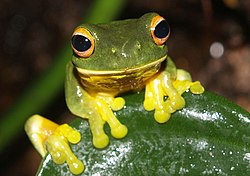Pelodryadinae
| Pelodryadinae Temporal range:
| |
|---|---|

| |
| Orange-thighed frog (Ranoidea xanthomera) | |
| Scientific classification | |
| Domain: | Eukaryota |
| Kingdom: | Animalia |
| Phylum: | Chordata |
| Class: | Amphibia |
| Order: | Anura |
| Family: | Hylidae |
| Subfamily: | Pelodryadinae Günther, 1858 |
| Type genus | |
| Pelodryas Günther, 1858
| |
| Synonyms | |
| |
Pelodryadinae, also known as Australian treefrogs (although not all members are arboreal), is a subfamily of frogs found in the region of Australia and New Guinea, and have also been introduced to New Caledonia, Guam, New Zealand, and Vanuatu.[2]
The subfamily is thought to be the sister group to the leaf frogs (Phyllomedusinae), a subfamily of arboreal frogs known from the Neotropics. The common ancestor of both subfamilies is thought to have lived in early Cenozoic South America, with the two subfamilies diverging from one another during the Eocene. The ancestors of the subfamily Pelodryadinae likely invaded Australasia via the Antarctic land bridge, which at the time was not yet frozen over, thus was hospitable for the dispersing frogs.[3] The clade comprising both subfamilies is sister to the Hylinae, from which they diverged in the early Paleogene.[4]
The oldest known fossil of a frog of the Pelodryadinae is of †Litoria tylerantiqua from 55 million years ago. This places a minimum age on the divergence of this group from the Phyllomedusinae, and confirms that these two groups must have likely diverged even earlier.[1]
Classification
[edit]The subfamily contains 222 species in three genera:[2]
- Litoria Tschudi, 1838 (102 species)
- Nyctimystes Stejneger, 1916 (44 species)
- Ranoidea Tschudi, 1838 (71 species)
- Genus incertae sedis (5 species)
- "Litoria" castanea (Steindachner, 1867)
- "Litoria" jeudii (Werner, 1901)
- "Litoria" louisiadensis (Tyler, 1968)
- "Litoria" obtusirostris Meyer, 1875
- "Litoria" vagabunda (Peters and Doria, 1878)
The following fossil genera are also known:[1]
- †Australobatrachus Tyler, 1976 - Oligocene or Miocene of South Australia[5]
- †Etnabatrachus Hocknull, 2003 - Pliocene or Pleistocene of Mount Etna, Queensland
References
[edit]- ^ a b c Farman, roy M.; Archer, Michael; Hand, Suzanne J. "Early Eocene pelodryadid from the Tingamarra Local Fauna, Murgon, southeastern Queensland, Australia, and a new fossil calibration for molecular phylogenies of frogs". Journal of Vertebrate Paleontology. 0 (0): e2477815. doi:10.1080/02724634.2025.2477815. ISSN 0272-4634.
- ^ a b "Pelodryadinae Günther, 1858 | Amphibian Species of the World". amphibiansoftheworld.amnh.org. Retrieved 2022-08-26.
- ^ Duellman, William E.; Marion, Angela B.; Hedges, S. Blair (2016-04-19). "Phylogenetics, classification, and biogeography of the treefrogs (Amphibia: Anura: Arboranae)". Zootaxa. 4104 (1): 1–109. doi:10.11646/zootaxa.4104.1.1. ISSN 1175-5334. PMID 27394762.
- ^ Feng, Yan-Jie; Blackburn, David C.; Liang, Dan; Hillis, David M.; Wake, David B.; Cannatella, David C.; Zhang, Peng (2017-07-18). "Phylogenomics reveals rapid, simultaneous diversification of three major clades of Gondwanan frogs at the Cretaceous–Paleogene boundary". Proceedings of the National Academy of Sciences. 114 (29): E5864 – E5870. Bibcode:2017PNAS..114E5864F. doi:10.1073/pnas.1704632114. ISSN 0027-8424. PMC 5530686. PMID 28673970.
- ^ Tyler, Michael J. (1986-01-01). "Additional records of Australobatrachus ilius (anura: Hylidae) from the Tertiary of South Australia". Alcheringa: An Australasian Journal of Palaeontology. 10 (4): 401–402. doi:10.1080/03115518608619147. ISSN 0311-5518.

